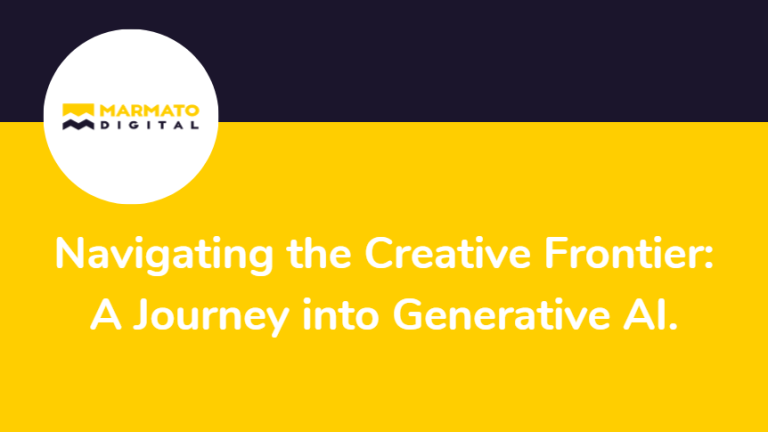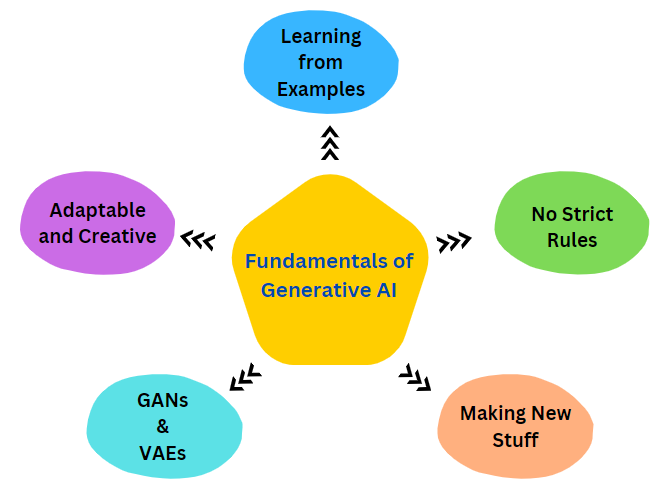In the world of artificial intelligence, one of the most intriguing and promising fields is Generative AI. This cutting-edge technology has gained significant attention for its ability to create content, mimic human creativity, and generate novel outputs across various domains. In this post, let’s explore what is generative AI, the fundamentals of Generative artificial intelligence, its applications, challenges, and the potential it holds for revolutionizing industries.

What is Generative AI?
Generative AI, short for Generative Artificial Intelligence, is a part of artificial intelligence that focuses on making computer algorithms that can create new and original stuff, just like humans. Unlike regular AI, which follows specific rules, generative models learn from big data sets. This helps them make all sorts of relevant things without clear instructions.
Now you know an overview of what is Generative AI. Moving forward, let’s dive deep and know more about its fundamentals.
Fundamentals of Generative AI:
Basically, Generative AI is like a super-smart computer that learns from examples and uses that knowledge to make all sorts of creative and new things. It’s like a digital artist that can adapt and create in many ways!

• Learning from Examples:
Generative AI tries to copy human-like creativity. It learns from many examples in data, like pictures or sentences, to understand patterns, styles, and how things work. This way, it can make things that are not exact copies but new and creative based on what it learned.
• No Strict Rules:
Unlike regular computer programs with strict rules, generative models don’t have a fixed set of instructions. So, these models can adapt and create content in different areas like images, text, music, etc. They learn on their own, which makes them flexible and creative.
• Making New Stuff:
Once it learns from examples, the AI can make new things it hasn’t seen before. It’s like an artist creating unique paintings based on what it learned from other artworks.
• GANs and VAEs
To learn, these models are trained on large data sets. Different techniques exist, like Generative Adversarial Networks (GANs) and Variational Autoencoders (VAEs). GANs, where the computer has a creative battle with itself, improving over time. VAEs focus on simplifying information to create new things.
• Adaptable and Creative:
It can be creative in different areas, like making realistic images, writing exciting text, or even composing music. It’s like having a smart assistant who makes things look and sound cool.
Applications of Generative AI in Various Industries:
Generative AI can be creative in different areas, like making realistic images, writing interesting text, or even composing music. It’s like having a smart assistant who makes things look and sound cool.
• Content writing assistance:
One of the most prominent uses is creative writing assistance, where AI algorithms can help writers overcome writer’s block and generate fresh ideas. These algorithms can suggest plotlines, characters, and even dialogue options by analyzing vast amounts of text data.
• Design and Creativity:
From art and music to graphic design, Generative AI empowers creative professionals by assisting in ideation, iteration, and generating unique designs. Artists can now collaborate with AI systems to create unique and visually stunning pieces. These systems analyze patterns, styles, and techniques from existing artwork to generate novel compositions pushing traditional artistic expression’s boundaries.
• Image and Video Synthesis:
Generative models can create realistic images and videos, ranging from lifelike faces to entire scenes, opening avenues for the entertainment and gaming industries.
• Healthcare and Drug Discovery:
Generative AI aids in generating molecular structures, predicting protein folding, and accelerating drug discovery processes, offering significant advancements in the medical field.
• Natural Language Processing (NLP):
Generative AI also significantly enhances virtual reality experiences. Generative models can write coherent and contextually relevant text in language, making them valuable for content creation, chatbots, and automated writing. This creates dynamic and interactive experiences that adapt to real-time user preferences.
As generative AI evolves, its applications will only expand further across industries. From assisting creative professionals in their work to enhancing user experiences in virtual reality, this technology holds immense potential for innovation and advancement in various fields.
Ethical Considerations of Generative AI:
As the capabilities of generative AI continue to advance, it is crucial to acknowledge the hurdles and ethical considerations accompanying its immense potential. Let’s delve into the challenges that come with this cutting-edge technology:
1. Bias in Generated Content:
Generative AI learns from vast datasets, and if these datasets contain biases, the AI can unintentionally reproduce and amplify them. For example, if the training data is biased towards a certain group, the generated content may reflect those biases. Addressing and mitigating bias is a significant challenge in ensuring fair and unbiased AI applications.
2. Ethical Concerns with Deepfakes:
Deepfakes are hyper-realistic synthetic media created by Generative AI, often involving the manipulation of images or videos to make them appear real. While this technology has entertaining applications, it raises ethical concerns, especially when spreading misinformation or creating malicious content. Safeguarding against the misuse of deepfakes is a critical ethical consideration.
3. Security Measures to Prevent Malicious Use:
Generative AI’s capability to create realistic content also poses security challenges. Malicious actors could exploit this technology to generate fake identities and misinformation or even create convincing phishing attacks. Implementing robust security measures becomes imperative to prevent the misuse of Generative AI for malicious purposes.
Benefits of Using Generative AI for Digital Marketing Content Creation:
By harnessing the power of generative AI, digital marketers can unlock a new level of efficiency and creativity.
- Time-saving automation: With generative AI, content creation becomes streamlined. Tasks that take hours or even days can now be completed in a matter of minutes. This allows marketers to focus on other important aspects of their campaigns while leaving the content generation to the AI.
- Creativity: Generative AI has limitless creativity potential. It can produce unique, engaging content that captures attention and resonates with target audiences. This technology can generate fresh ideas and perspectives that may have been overlooked, providing marketers with constant inspiration.
- Personalization: Personalized content generation is another significant benefit offered by generative AI. By leveraging user data and preferences, AI algorithms can tailor content to individual customers, enhancing customer experiences and driving higher engagement rates.
- Increased Productivity: In addition to saving time and boosting creativity, generative AI enhances productivity by streamlining workflows and reducing manual labor. Marketers no longer need to start from scratch or spend hours brainstorming ideas; instead, they can rely on AI-powered tools to provide a solid foundation for their campaigns.
- Innovation: Lastly, it opens new possibilities for innovation in digital marketing strategies. It can identify patterns in consumer behavior or emerging trends that humans might miss, leading to more effective campaigns and better results.
Conclusion:
In summary, Generative AI has an exciting future ahead. As technology gets better, it will be a big part of how we create personalized content and solve problems innovatively. The potential is enormous, and we’re heading towards a future where artificial intelligence and human creativity work together to achieve amazing things. It’s a journey of constant improvement, ethical thinking, and a significant impact on different industries and creative activities.
As we navigate the exciting landscape of Generative AI, staying vigilant about the challenges and addressing ethical considerations is essential for harnessing its power for positive advancements while minimizing potential risks. It’s a collective responsibility to ensure that it contributes positively to our world without compromising fairness, security, and ethical standards.
Take your next step towards unlocking the potential of Generative AI for your business!
If you’re ready to harness the power of Generative AI for your business or creative projects, Marmato Digital is here to help you navigate this cutting-edge technology. Our team of experts specializes in seamlessly integrating Generative AI solutions, tailoring them to meet your unique needs. Whether you want to enhance content creation, streamline design processes, or innovate problem-solving, we have the expertise to guide you.
Contact us today to explore how we can elevate your creativity and efficiency through the transformative capabilities of Generative AI. Let’s embark on a journey of innovation and intelligence together!
Subscribe to blogs
Get our latest blogs directly to your inbox.

